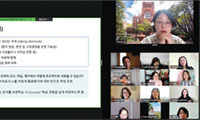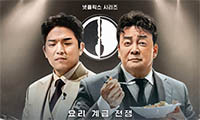Korean Americans Return to District Torn by Riots
Scars from 1992 linger, but many shops have reopened and owners have learned how to fit
in better.
By K. Connie Kang
Times Staff Writer
Reprinted with permission
from the Los Angeles Times
Eight years after hundreds of Korean Americans lost their life savings in the fire and fury of the Los Angeles riots, a growing number of merchants are returning to South-Central and nearby areas, scenes of some of the worst firebombings and lootings.
Memories and scars of the riots’ devastation still linger, the images of those nightmarish days indelibly etched in the Korean American psyche in the term sa-ee-gu, meaning 4/29-or April 29, the start of the riots.
Korean-owned businesses lost an estimated $400 million in the three days of rioting in 1992, propelling horrified merchants to leave South-Central in droves, vowing never to return. The rioting erupted hours after a Simi Valley jury pronounced four police officers not guilty of using excessive force in the beating of Rodney G. King.
While many Korean riot victims continue to struggle with poor health, domestic problems and financial hardships brought on by sa-ee-gu, others have put the past behind them, finding viable economic opportunities in southern Los Angeles.
Quietly and largely unnoticed, many have come in from other neighborhoods and other vocations; others have rebuilt on the ashes of the riots-and are thriving.
SHOPS:Costly Lessons Learned
Having learned costly lessons from the riots, Korean American grocers today are striving to avert cultural misunderstandings and improve relations with their primarily black and Latino customers. They smile more often and strike up conversations with customers, traits that do not come naturally in the Korean culture, which equates silence with dignity.
They are reaching out to their customers more and taking note of important events in the patrons’ lives.
Frank Yim, whose market was emptied by looters during the riots, makes sure he remembers birthdays, weddings-and especially funerals.
"Mr. Yim was very supportive when my sister died," said Delores Morris, who has lived in South-Central most of her 43 years. Morris said Yim sent flowers and contributed food. He did the same thing when her uncle died.
These are experiences Yim did not even imagine were possible before sa-ee-gu, he said.
The improved economy, decreasing crime, better policing and continuing exchanges between black and Korean churches have also contributed to a greater sense of harmony.
Joe R. Hicks, executive director of the Los Angeles Human Relations Commission, says he is pleased with the progress he sees when he visits South-Central.
"It’s one of the better stories of improving human relations," he said, "that hasn’t been told."
A Warm Welcome
Friends of Sunae and Jang-Hwan Lee were incredulous when the two said last year that they were venturing into South-Central. "As if running a market in Gardena isn’t bad enough, you want to go to South-Central?" the friends chided the couple.
In many Korean minds, the neighborhood had become synonymous with high crime and troublesome customers.
The Lees said their anxiety about doing business in South-Central vanished when customers welcomed them warmly, addressing Sunae Lee as "Mama-san." It didn’t matter that her well-meaning patrons were using the Japanese suffix san, denoting respect, to a Korean.
"We’re glad to be here," said Sunae Lee as she waited on customers, conversing in English and Spanish. "Customers are good to us; we are quite satisfied."
Sometimes, regular customers seem like part of their extended family, her husband said.
Interviews with more than two dozen grocers and visits to numerous establishments testify to changes in appearance and to exchanges taking place inside shops.
Largely gone are graffiti-scarred storefronts and young men loitering outside. Stores are cleaner inside and out. Pride of ownership is evident.
A big sign, "Thank You for Shopping Here" is the first thing that greets customers entering Kyung-Hoon Park’s Three Star Market and Liquor on South Avalon Boulevard.
Park, a former transmission parts salesman, is also a newcomer to South-Central. He bought his store 18 months ago and remodeled and expanded it.
Park was an experienced Korean American manager, and like other merchants, has taken steps to hire non-Koreans for his staff. He is so optimistic about his business prospects in the area
that he is looking to invest in more markets.
Residents and shopkeepers said they used to hear gunshots, even at dusk. These days, residents walk to markets at night. LAPD crime statistics corroborate the impression of safer streets. Robberies in the area, for example, have declined consistently in the last three years.
"We haven’t had any problem in the year and half we’ve been here," said Park.
Willie Grayson, an African American customer whose relationship with the store predates the present owner, agreed.
Troublemakers "don’t hang out like they used to," he said. "There isn’t much drinking outside in the neighborhood."
Grayson said he feels safe walking to the store, even at night. "It’s better-friendlier," he said. "A lot of people get along."
Attractive Investments
Real estate agents say Korean Americans with access to a lot of capital still prefer to invest in Koreatown, the Mid-Wilshire District, the Westside, the San Fernando Valley and the South Bay. But for those with limited capital, South-Central and other inner-city neighborhoods offer attractive investment opportunities because leases and rents are cheaper.
"Koreans want to work for themselves," said real estate man Richard Kim, president of BCI in Koreatown. As soon as they can get together enough money-$50,000 or so-they’re ready to buy a $100,000 business, he said.
In the past several years, Koreans have bought more than 100 businesses in South-Central alone, bringing to about 400 the total number of Korean-owned businesses there, according to Ellis Cha, president of the Korean American Grocers Assn.
That’s a significant increase since the riots’ immediate aftermath, when the number of Korean-owned stores fell from 500 to fewer than 300, according to the grocers group, which has, 1,100 dues-paying members in Los Angeles County and 4,000 statewide.
Liquor license records at the state Alcoholic Beverage Control Board confirm the trend. An analysis of the records issued for businesses in Los Angeles County shows that Koreans are buying establishments in South-Central at a brisk rate-more than any other ethnic group.
Dal-Yong Lee, who buys rundown markets, fixes them up and resells them, says he can’t keep up with the demand. Criticized as being unfriendly and rude before the riots, Korean Americans are striving to earn a more positive image.
"How are you doin’ today, my son?" a Korean American store keeper said to a familiar African American customer in his 20s. "Haven’t seen you in a while."
"I moved, man," the African American said.
"Give me your phone number then, son," the Korean American said, handing over a sheet of paper.
The customer obliged with a smile. "Bye, Papa-san," he said as he sauntered out of the store.
Such outward signs of friendliness are no simple undertaking for first-generation Korean Americans, who hail from a culture in which silence is golden and idle talk frowned on.
Shopkeepers are also conversing more in Spanish with Latino customers since the riots, the change coinciding with the increase in numbers of Spanish-speaking patrons in the area.
"My customers appreciate the fact that I speak Spanish to them," said Elizabeth Kim, who with her husband, Benedict, owns Santa Fe Market in Huntington Park, another area popular with Korean American entrepreneurs.
Though a cultural gulf exists between Latinos and Koreans, their commonality as immigrants makes their encounters go more smoothly, Kim and other shopkeepers said.
Hicks said it took "a lot of work to see each other with honesty and engage in the hard work of building new relationships."
What merchants have done is "sink roots into the community," and they have responded to criticisms by being "more sensitive and intimate" with the communities they serve, Hicks said. For their part, residents more readily acknowledge a "vital function" that merchants perform, he said.
"I see a drastic improvement in the relationship between Koreans and African Americans," said the Rev. Leonard Jackson of First AME Church. Jackson said his church’s choir now includes a handful of Korean Americans, and when he looks out at his large congregation on Sundays, he spots a group of Koreans.
"We are on the right track," he said.
Economist Jack Kyser agreed: "If you go out into the community, what you see are people from all types of backgrounds living and working together side by side."
On the economic front, the metropolitan area’s recovery from the riots is a "mixed bag," said Kyser, chief economist at the Los Angeles County Economic Development Corp. "We have come a good ways, but we haven’t come as far as you would like."
Los Angeles County still has 140,000 fewer jobs than it did in December 1989, the region’s economic peak, Kyser said. Along with the riots, the area also was affected by corporate restructuring and the economic downturn of the early 1990s.
"We are going to all have to work together more effectively because, overall, the business environment is changing very rapidly," Kyser said. "It’s going to take innovative thinking."
No Bitterness
Before sa-ee-gu, Jae-Yul Kim, 56, owner of One Stop Mart at Arlington and 43rd streets, was worth millions on paper, in contrast to most Korean merchants, who operated on thin margins. He owned two businesses, including a sizable lot, and an Encino home with a swimming pool and tennis courts.
In less than two decades in the United States, he had made it. But arsonists set his market on fire and he hit a downward economic spiral.
Today, Jae-Yul Kim, standing behind his meat counter wearing a red apron, shrugs when he says that he cannot even buy a new van he needs.
"Because of my credit, they want me to pay 19.5% interest on a car loan," he said. So he had his 1980 Ford Econoline repaired.
Taking a deep breath, he said with a sheepish smile, "That’s how it is with us."
Despite all the losses he and his wife, Nina, suffered, they show no trace of bitterness.
He says sa-ee-gu has changed his philosophy.
"My business has gone from the place where I made money to the place where I live my life," he said.
Helplessness that he and other riot victims felt after the upheaval also made him become more active in the community. He attends block meetings; he and other area Korean American grocers belong to the Boosters Club, which supports the local police.
In the pre-riot days, the Kims worked all their waking hours. But now, they take one day off every week, leaving the store to their son and in-laws.
He has become more Angeleno in other ways, too. A son and a
In the past several years, Koreans have bought
more than100 businesses in South-Central alone,
bringing to about 400 the total number of Korean-owned
businesses there, according to Ellis Cha, president
of the Korean American Grocers Assn.
daughter have married Mexican Americans. Kim has three racially mixed grandchildren.
Though interracial marriages are still eschewed in the Korean community, the Kims have come to accept it as an L.A. reality. "Sooner or later, we [in Los Angeles] will get all mixed up," he said. "Our family is simply starting sooner."
Lending Expertise
Korean Americans own tens of thousands of convenience stores in the United States, from Los Angeles to New York.
"Koreans [immigrant] cannot find good jobs [commensurate] with their education because of the language and lack of experience in the mainstream," said the grocer group’s Cha, explaining why so many choose to go into the business.
The group’s national membership, which includes about two-thirds of the store owners, is 23,500.
To help members improve their profit margins, association officials like Cha and Bong-Soo Lee have been lending their expertise.
Last year alone, Cha and Lee worked with more than 50 Korean American merchants to help improve their businesses. They analyzed businesses and recommended improvements ranging from reorganizing shelves to investing in better lighting and security.
Lee’s gross income from his Daily Market business has grown steadily since he expanded his store. He attributes his success to being attentive to his customers.
"Before sa-ee-gu, I felt resentful toward customers who bought only the things at my store that were cheaper than in other stores," he said. "But my changed attitude has enabled me to remind myself, ‘I should be grateful that they bought anything at all.’"
He tells other grocers that they can’t go wrong addressing customers "Yes, sir," and "Yes, ma’am," especially when they are difficult.
One woman who frequents their store used to try to pick fights with his wife whenever the customer was in a bad mood, he said.
"My wife decided that no matter what she said she was going to respond, ‘Yes, ma’am.’"
It worked, he said: "She used to call me ‘Hey, Lee." These days she calls me ‘Mr. Lee.’"
스마터리빙
more [ 건강]
[ 건강]이제 혈관 건강도 챙기자!
[현대해운]우리 눈에 보이지 않기 때문에 혈관 건강을 챙기는 것은 결코 쉽지 않은데요. 여러분은 혈관 건강을 유지하기 위해 어떤 노력을 하시나요?
 [ 건강]
[ 건강]내 몸이 건강해지는 과일궁합
 [ 라이프]
[ 라이프]벌레야 물럿거라! 천연 해충제 만들기
 [ 건강]
[ 건강]혈압 낮추는데 좋은 식품
[현대해운]혈관 건강은 주로 노화가 진행되면서 지켜야 할 문제라고 인식되어 왔습니다. 최근 생활 패턴과 식생활의 변화로 혈관의 노화 진행이 빨라지고
사람·사람들
more많이 본 기사
- “여객기서 빈대 물렸다” 美·유럽 항공사 상대 억대 손배소
- 맘다니 뉴욕시장 취임위원회에 ‘파친코’ 이민진 작가
- 성탄절 캘리포니아 이틀째 악천후…최소 2명 사망
- 쿠팡 유출 한달 만에 용의자 특정…동기·2차피해는 여전히 베일
- 트럼프 얹은 케네디센터 개명 싫어 연례 성탄콘서트 취소
- 잘나가던 백종원, 논란에 흔들.. ‘흑백요리사2’ 복귀로 웃을까?
- 교황, 첫 성탄 메시지서 “우크라전 종전 직접 대화할 용기 찾길”
- 여성 살해·자녀 납치 한인 ‘수배’
- 우크라, 성탄절에 드론·英미사일로 러 에너지시설 공격
- 남가주 전역에 ‘물폭탄’… 성탄 연휴 ‘대혼란’
- “소변 불편한데 주저하다 방광 망가져”
- 체포 불체자 수만명 물류창고에 수감 추진
- 이스라엘군 “레바논서 이란 정예부대 군인 사살”
- 한인타운 한복판 주유소서 강도 ‘칼부림’
- “대학 학자금 상환 안하면 임금 압류한다”
- 트럼프, 성탄절 어린이들과 통화… “나쁜 산타 막을게”
- ‘라스베가스에서 만난 한인들’
- “마가, 유럽에 첫 공격”…표현의 자유 둘러싼 전쟁 시작됐나
- 새해 더 건강해지기 위한 의사의 과학적 조언 10가지
- 난방기 뜯자 ‘비밀공간’ 은신 마피아 보스 체포
- [2025년 한 해 ‘진 별’들] 미주 한인사회 원로들 ‘역사의 뒤안길’로
- 테슬라, “비상사태 시 차문 안 열려”
- 북한인, 아마존 위장취업 대거 적발
- SF기독대학교’동문의 밤’
- CBS가 보류한 ‘불법체류자 추방’ 보도, 캐나다서 원본 유출
- 러 “푸틴, 트럼프에 ‘메리 크리스마스’…젤렌스키는 야만적”
- “불교계 화합과 차세대 육성 축제”
- 서태지, 딸·엘리와 1년 만에 근황 “좋은 소식 없어 안타까워”
- 박나래, 과거 또 파묘..이번엔 ‘나혼산’ 18L 식용유 장면
- VA 페어팩스 카운티 실업자 급증
- 북가주목회자 사모회 총회
- 봉사 가치 되새기고 발전 방안 모색
- “한반도 평화정착에 앞장선다”
- 워싱턴 총신동문회, 새 회장에 김찬영 목사
- H-1B ‘10만 달러 수수료’ 연방법원, 이의소송 기각
- 한국외대·연세대·한양대 GCEO 연합골프대회 성황
- LA 마약조직 집중 단속 갱단원 등 수백명 체포
- 국기원 MD지부, 고단자 심사 실시
- 월드미션칼리지 장학금 수여식
- 황해도민회 석경회 송년모임
- “음주운전 대신 15불 할인하는 리프트 타세요”
- 상록회 “한 해 동안 함께여서 행복했습니다”
- 선우용여 “아들, 돈 없어 개밥 먹기도..아파트 마련해줬다”
- 크리스마스 연휴 음주운전 ‘꼼짝마’
- 레저월드 홀인원 골프클럽 송년모임
- 원·달러 환율, 당국 개입에 42원 폭락
- “아름답게 장식하세~”… 청소년재단 특별수업
- 트럼프 ‘전쟁할 결심’?… 미군 특수부대 카리브해 이동
- 뚜레쥬르, 뉴욕시 맨해튼 매장 오픈
- 샌프란시스코, 한국 방문해 이정후와 함께 야구 클리닉
1/5지식톡

-
 미 육군 사관학교 West Poin…
0
미 육군 사관학교 West Poin…
0https://youtu.be/SxD8cEhNV6Q연락처:wpkapca@gmail.comJohn Choi: 714-716-6414West Point 합격증을 받으셨나요?미 육군사관학교 West Point 학부모 모…
-
 ☝️해외에서도 가능한 한국어 선생님…
0
☝️해외에서도 가능한 한국어 선생님…
0이 영상 하나면 충분합니다!♥️상담신청문의♥️☝️ 문의 폭주로 '선착순 상담'만 진행합니다.☎️ : 02-6213-9094✨카카오톡ID : @GOODEDU77 (@골뱅이 꼭 붙여주셔야합니다…
-
 테슬라 자동차 시트커버 장착
0
테슬라 자동차 시트커버 장착
0테슬라 시트커버, 사놓고 아직 못 씌우셨죠?장착이 생각보다 쉽지 않습니다.20년 경력 전문가에게 맡기세요 — 깔끔하고 딱 맞게 장착해드립니다!장착비용:앞좌석: $40뒷좌석: $60앞·뒷좌석 …
-
 식당용 부탄가스
0
식당용 부탄가스
0식당용 부탄가스 홀세일 합니다 로스앤젤레스 다운타운 픽업 가능 안녕 하세요?강아지 & 고양이 모든 애완동물 / 반려동물 식품 & 모든 애완동물/반려동물 관련 제품들 전문적으로 홀세일/취급하는 회사 입니다 100% …
-
 ACSL 국제 컴퓨터 과학 대회, …
0
ACSL 국제 컴퓨터 과학 대회, …
0웹사이트 : www.eduspot.co.kr 카카오톡 상담하기 : https://pf.kakao.com/_BEQWxb블로그 : https://blog.naver.com/eduspotmain안녕하세요, 에듀스팟입니다…
케이타운 1번가
오피니언
 스티브 강 전 한인민주당협회 회장
스티브 강 전 한인민주당협회 회장 [스티브 강 ‘인사이드 미국’] 2026 중간선거: 트럼프 지지율 하락이 말해주는 것
 김홍일 케이유니콘인베스트먼트 대표
김홍일 케이유니콘인베스트먼트 대표 [기고] 안정의 기준은 어떻게 제도가 되었나
 유혜미 한양대 경제금융대학 교수
유혜미 한양대 경제금융대학 교수 [유혜미 칼럼] 치솟는 환율, 경제 지표의 역설
 성민희 소설·수필가
성민희 소설·수필가 [윌셔에서] 우리 안의 ‘생각하는 사람’을 깨울 시간
 김정곤 / 서울경제 논설위원
김정곤 / 서울경제 논설위원 [만화경] 해수부 부산시대

[왈가 왈부] 내란재판부·정통망법 또 수정… 졸속·땜질 아닌가요
 정숙희 논설위원
정숙희 논설위원온라인쇼핑과 반품, 그리고 그 이후
 파리드 자카리아 / 워싱턴포스트 칼럼니스트 / CNN ‘GPS’ 호스트
파리드 자카리아 / 워싱턴포스트 칼럼니스트 / CNN ‘GPS’ 호스트 트럼프의 새 독트린 “미국을 다시 왜소하게”
 김동찬 시민참여센터 대표
김동찬 시민참여센터 대표 [미국은 지금] MAGA의 분열, 예견된 균열의 시작
1/3지사별 뉴스

“온 세상에 평화를⋯”
숨가쁘게 달려온 2025년을 이제 1주일 남짓 남긴 채 크리스마스 이브를 맞는다. 다사다난했던 한 해를 되돌아보며 마무리하는 연말 시즌과 크리…
H-1B비자 고임금·경력자에 우선권

“한반도 평화정착에 앞장선다”
민주평화통일자문회의 미주지역회의(부의장 이재수)는 22일 기자회견을 통해 내년도 활동 방향과 목표를 밝혔다. 이재수 부의장은 “미주지역회의는…
VA 페어팩스 카운티 실업자 급증

한인들 위한 무료 법률 상담회 개최
샌프란시스코 베이지역 한인회(회장 김한일)는 지난 20일 한인회관에서 북가주 지역 한인들을 위한 무료 법률 상담회를 개최했다. 이날 행사에는 …
여성 살해·자녀 납치 한인 ‘수배’

오늘 하루 이 창 열지 않음 닫기 





















































.png)


댓글 안에 당신의 성숙함도 담아 주세요.
'오늘의 한마디'는 기사에 대하여 자신의 생각을 말하고 남의 생각을 들으며 서로 다양한 의견을 나누는 공간입니다. 그러나 간혹 불건전한 내용을 올리시는 분들이 계셔서 건전한 인터넷문화 정착을 위해 아래와 같은 운영원칙을 적용합니다.
자체 모니터링을 통해 아래에 해당하는 내용이 포함된 댓글이 발견되면 예고없이 삭제 조치를 하겠습니다.
불건전한 댓글을 올리거나, 이름에 비속어 및 상대방의 불쾌감을 주는 단어를 사용, 유명인 또는 특정 일반인을 사칭하는 경우 이용에 대한 차단 제재를 받을 수 있습니다. 차단될 경우, 일주일간 댓글을 달수 없게 됩니다.
명예훼손, 개인정보 유출, 욕설 등 법률에 위반되는 댓글은 관계 법령에 의거 민형사상 처벌을 받을 수 있으니 이용에 주의를 부탁드립니다.
Close
x